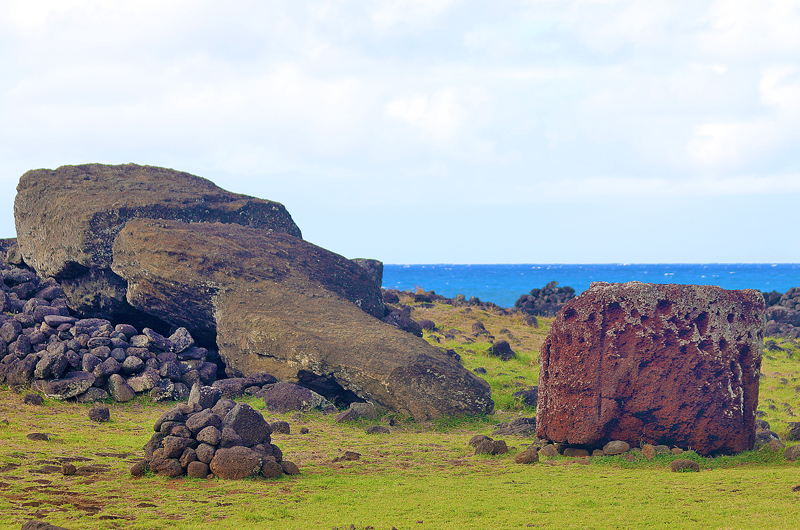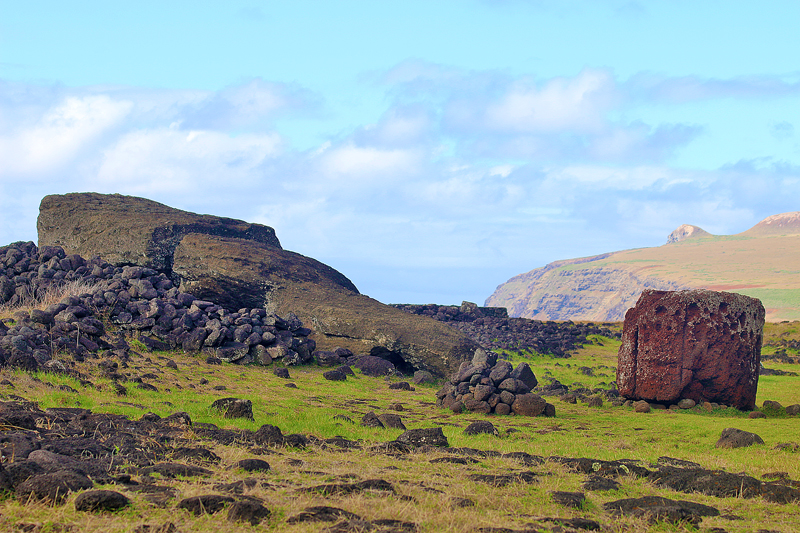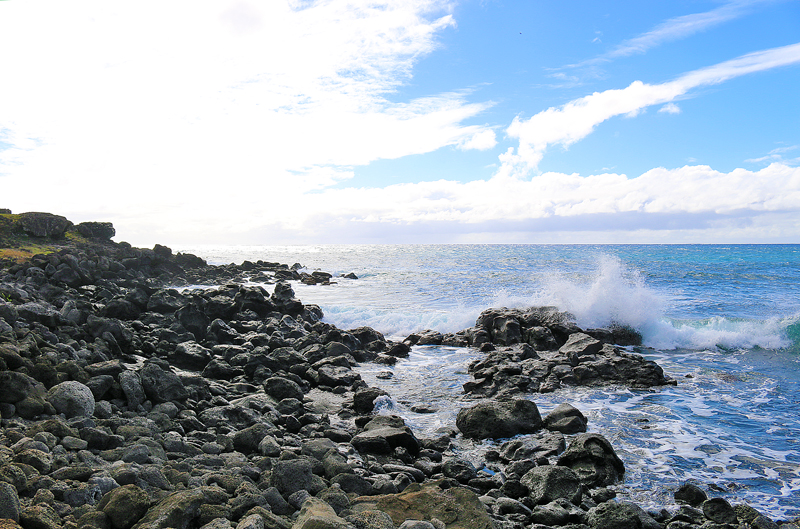One would never know that the Paro Moai was the largest statue ever moved and successfully erected on an ahu on Easter Island simply by viewing its remains after it collapsed almost 200 years ago, as it is lying on the ground face down with its body split in half along the rocky northeastern coast by the Bay of La Pérouse…
The Largest Statue Ever Moved and Successfully Erected on Easter Island: Ahu Te Pito Kura

…but within the ceremonial center of the archaeological complex known as Ahu Te Pito Kura — whose only moai is named Paro and whose name means navel of light — the ahu itself remains in the same position as it has for centuries; and the Paro Moai represents a milestone from the period when the statues were built, as it is the largest moai statue to be transported from the volcano quarry known as Rano Raraku and erected successfully on an ahu or platform.
According to tradition — or legend, if you prefer — a widow commissioned the construction of Paro Moai in memory of her late husband.

The Paro Moai stood at almost ten meters in height; its weight is greater than 80 tons; and its ears measure two meters in length. Ahu Te Pito Kura is known as the ahu of the last moai, as Paro Moai may well have been one of the last statues to be knocked down from its ahu — likely shortly after the year 1838, as no records of the visitors seeing a standing moai exist.

Near the head of the fallen Paro Moai lies its dark red gigantic pukao, which at almost two meters in height and approximately 12 tons in weight is considered one of the most voluminous headdresses which was carved and transferred from the quarry of Puna Pau. A trip report of that quarry will be covered in a future article here at The Gate.

The Magnetic Stone

Adjacent to Paro Moai is a large smooth stone, which was formerly known as Tita’a hanga ‘o te henua — of which Te Pito O Te Henua means navel of the world. The stone is almost spherical at approximately 80 centimeters in diameter, with four smaller stones surrounding it.

According to legend, the singular stone was brought by Hotu Matu’a — who was the founding king of the Rapanui people — in his boat from his native land which was known as Hiva. This stone purportedly concentrates a magnetic and supernatural energy called mana.

This stone warms up more than other stones and causes the compass to behave strangely because of its high iron content. Visitors have been known to place their hands on the stone to capture their energy or — according to the belief of some people — increase fertility in women.
Some tourists have even gone so far as to perform some obscene act on the stone as an homage to the supposed power of the stone, which is thought to be the reason why the circle of stones that surrounds it has since been closed.

Ahu Heiki’i is the largest ahu on Easter Island whose size and imposing appearance results in it standing out. It is located very near to Ahu Te Pito Kura and is close to Hanga Ho Onu, oriented according to certain stars; and three pukao is contained among its vestiges. Ahu Heiki’i has beautiful petroglyphs…

…but visitors can enjoy the picturesque views of the rocks along the Bay of La Pérouse — as well as the brilliant azure color of the Pacific Ocean.

Summary
Ahu Te Pito Kura is located on the northeastern coast of Easter Island approximately 19.5 kilometers northeast of Hanga Roa. Driving there is easy, as the entrance is marked well. The fastest route is to take the road which crosses the island in the direction of Anakena — then turn right at the junction towards Poike just before reaching the beach. Drive approximately two kilometers southeast of Ovahe beach and you will arrive near the La Pérouse cove, where you will park your vehicle in a small parking lot.
You can use a motor vehicle to get yourself within the vicinity of Ahu Te Pito Kura; but access beyond the parking area is by either walking a short distance or by using a bicycle.
Remember that Ahu Te Pito Kura is part of Parque Nacional Rapa Nui — which is the national park of Easter Island — and you must present your ticket at the checkpoint prior to entering. You will need to pay $80.00 in United States dollars just for admission into the areas of the national park; and the ticket may be purchased either on arrival at the airport or in the center of town of Hanga Roa, which is the only municipality on Easter Island.
Ensure that you please leave cultural features exactly as you find them during your visit.
Other articles pertaining to Easter Island include:
- Easter Island: Itinerary and Master Guide [Work In Progress]
- Easter Island is Not Only Statues: Ana Te Pora Lava Tunnel
- What You Need to Know About Renting a Vehicle and Driving on Easter Island
- Dogs Versus Horses on Easter Island
- Road Trip Around Easter Island
All photographs ©2019 by Brian Cohen.

